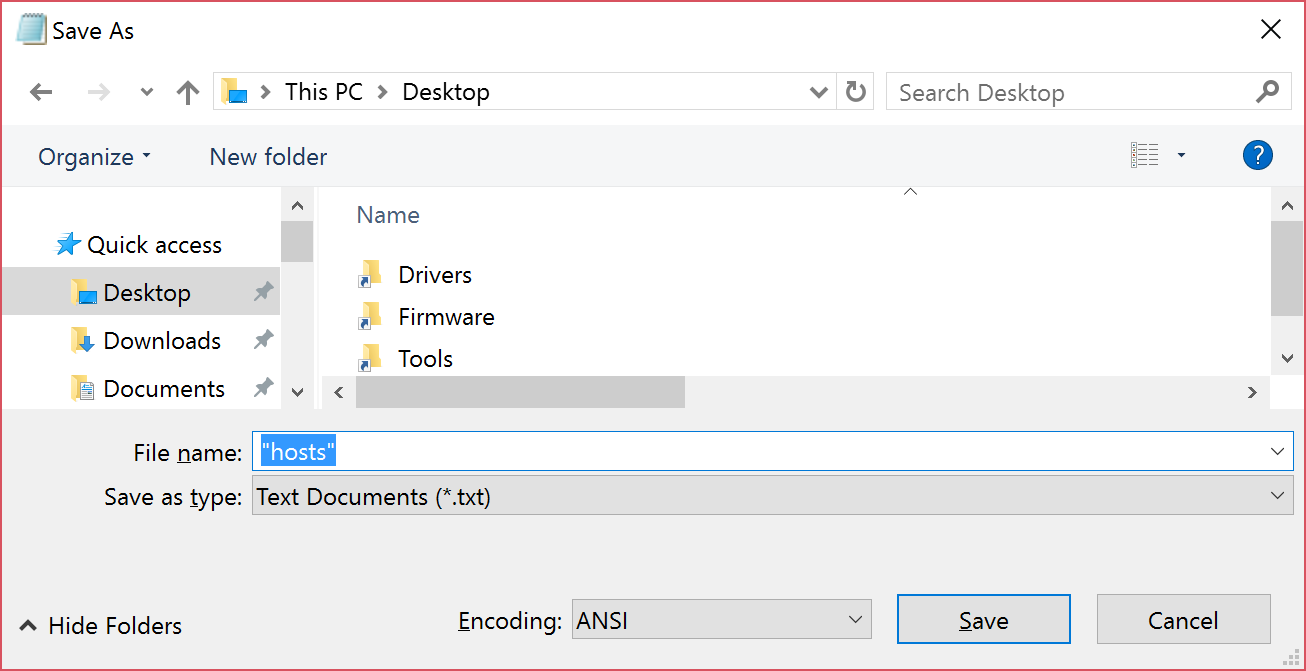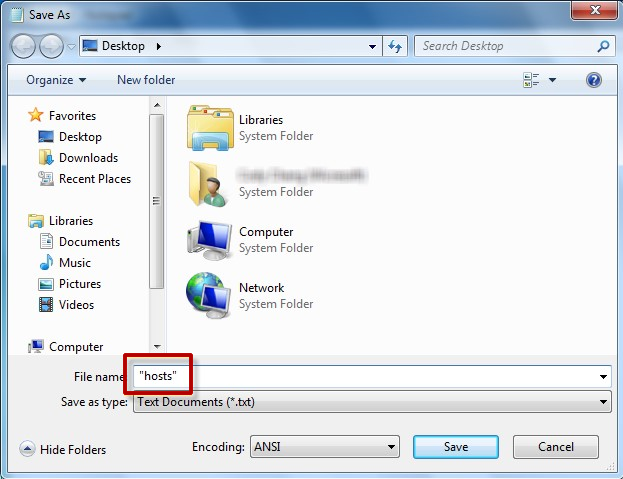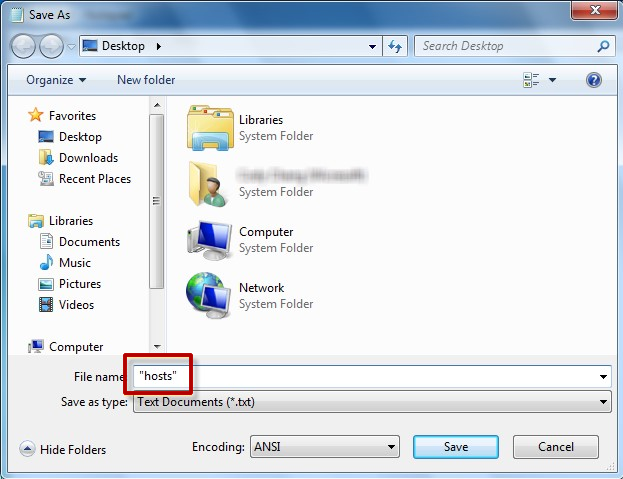Windows 10 Configuration Files Have Changed Please Add You Device Again
Windows 8 Windows eight.1 Windows 7 Windows Vista Windows XP Windows ten More than...Less
Summary
This article helps you reset the Hosts file back to the default.
What's the Hosts file
The Hosts file is used by the operating system to map human-friendly hostnames to numerical Cyberspace Protocol (IP) addresses which identify and locate a host in an IP network. The hosts file is one of several system resource that address network nodes in a computer network and is a common part of an operating system's IP implementation.
The Hosts file contains lines of text consisting of an IP address in the first text field followed by ane or more host names. Each field is separated by white space (Tabs are often preferred for historical reasons, but spaces are as well used). Comment lines may be included, and they are indicated past a hash grapheme (#) in the kickoff position of such lines. Entirely blank lines in the file are ignored.
If the Hosts file is changed from default, resetting it can help resolve some connectivity issues.
Resolution
To reset the Hosts file back to the default, follow these steps according to your operating system:
To reset the Hosts file dorsum to the default, follow these steps:
-
Open Notepad. To practise this, search for "Notepad" using Cortana, and then tap or click the Notepad icon.
-
Copy the following text, and so paste the text into the file: # Copyright (c) 1993-2006 Microsoft Corp. # # This is a sample HOSTS file used past Microsoft TCP/IP for Windows. # # This file contains the mappings of IP addresses to host names. Each # entry should exist kept on an individual line. The IP address should # be placed in the first column followed by the corresponding host proper name. # The IP address and the host proper noun should be separated past at least ane # space. # # Additionally, comments (such as these) may be inserted on individual # lines or following the machine proper noun denoted by a '#' symbol. # # For case: # # 102.54.94.97 rhino.tiptop.com # source server # 38.25.63.10 x.acme.com # x client host # localhost name resolution is handle within DNS itself. # 127.0.0.i localhost # ::1 localhost
-
On the File menu, selectSave every bit, blazon "hosts" in the File name box (as displayed in the following prototype), and then save the file to the desktop.

-
Close Notepad.
-
Search for %WinDir%\System32\Drivers\Etc using Cortana, and so select the File folder icon.
-
Tap and hold or right-click the Hosts file, select Rename, and then rename the file every bit "Hosts.old".
-
Copy or move the Hosts file that you created in step 3 from the desktop to the %WinDir%\System32\Drivers\Etc folder. If y'all are prompted to enter an ambassador password, select Go on.
To reset the Hosts file back to the default, follow these steps:
-
Open Notepad. To exercise this, swipe in from the right edge of the screen, tap Search, type Notepad, and then tap the Notepad icon. Or, if yous are using a mouse, bespeak to the upper-right corner of the screen, move the mouse pointer down, click Search, blazon Notepad, and so click Notepad.
-
Copy the post-obit text, and then paste the text into the file: # Copyright (c) 1993-2006 Microsoft Corp. # # This is a sample HOSTS file used by Microsoft TCP/IP for Windows. # # This file contains the mappings of IP addresses to host names. Each # entry should be kept on an individual line. The IP address should # exist placed in the first column followed by the corresponding host name. # The IP accost and the host name should be separated by at least one # infinite. # # Additionally, comments (such as these) may be inserted on individual # lines or following the machine name denoted by a '#' symbol. # # For example: # # 102.54.94.97 rhinoceros.acme.com # source server # 38.25.63.x x.pinnacle.com # x client host # localhost name resolution is handle within DNS itself. # 127.0.0.1 localhost # ::1 localhost
-
On the File menu, selectSalve as, blazon "hosts" in the File name box (as displayed in the following image), and then save the file to the desktop.

-
Close Notepad.
-
Open up the %WinDir%\System32\Drivers\Etc folder. To practise this, follow these steps:
-
Swipe in from the right edge of the screen, tap Search, type run, and then tap the Run icon. Or, if you are using a mouse, point to the upper-right corner of the screen, motion the mouse pointer down, selectSearch, blazon run, and then select the Run icon.
-
Blazon %WinDir%\System32\Drivers\Etc in the Open box, and and then selectOK.
-
-
Select the Hosts file, selectRename, and and then rename the file as "Hosts.old".
-
Re-create or move the Hosts file that you created in step 3 to the %WinDir%\System32\Drivers\Etc binder. If you are prompted to enter an administrator countersign, tap or click Continue.
To reset the Hosts file dorsum to the default yourself, follow these steps:
-
Click Start, click Run, type Notepad, and then click OK.
-
Re-create the post-obit text to the file:
For Windows 7 # Copyright (c) 1993-2006 Microsoft Corp. # # This is a sample HOSTS file used by Microsoft TCP/IP for Windows. # # This file contains the mappings of IP addresses to host names. Each # entry should be kept on an private line. The IP address should # be placed in the commencement column followed by the respective host name. # The IP address and the host proper name should be separated by at least one # infinite. # # Additionally, comments (such equally these) may be inserted on private # lines or following the machine proper name denoted by a '#' symbol. # # For example: # # 102.54.94.97 rhino.acme.com # source server # 38.25.63.10 ten.acme.com # x customer host # localhost name resolution is handle inside DNS itself. # 127.0.0.1 localhost # ::1 localhost For Windows Vista or for Windows Server 2008 # Copyright (c) 1993-2006 Microsoft Corp. # # This is a sample HOSTS file used by Microsoft TCP/IP for Windows. # # This file contains the mappings of IP addresses to host names. Each # entry should be kept on an private line. The IP address should # be placed in the first column followed by the corresponding host name. # The IP accost and the host name should be separated by at least one # space. # # Additionally, comments (such as these) may be inserted on individual # lines or post-obit the machine proper noun denoted by a '#' symbol. # # For instance: # # 102.54.94.97 rhinoceros.summit.com # source server # 38.25.63.x 10.pinnacle.com # 10 client host 127.0.0.1 localhost ::1 localhost For Windows XP or for Windows Server 2003 # Copyright (c) 1993-1999 Microsoft Corp. # # This is a sample HOSTS file used past Microsoft TCP/IP for Windows. # # This file contains the mappings of IP addresses to host names. Each # entry should be kept on an private line. The IP address should # be placed in the first column followed by the corresponding host name. # The IP address and the host name should be separated by at least i # infinite. # # Additionally, comments (such equally these) may exist inserted on individual # lines or following the motorcar name denoted by a '#' symbol. # # For example: # # 102.54.94.97 rhinoceros.acme.com # source server # 38.25.63.ten x.acme.com # 10 client host 127.0.0.one localhost
-
On the File menu, selectSalvage every bit, type "hosts" in the File name box, and so salvage the file to the desktop.

-
SelectStart >Run, type %WinDir%\System32\Drivers\Etc, and and then selectOK.
-
Select the Hosts file, and rename it "Hosts.old."
-
Copy or move the Hosts file that you lot created in step three to the %WinDir%\System32\Drivers\Etc folder. If yous are prompted to enter an ambassador countersign, selectContinue.
More than Information
Support for Windows XP has ended
Microsoft ended support for Windows XP on April 8, 2014. This modify has affected your software updates and security options. Learn what this means for you and how to stay protected.
Back up for Windows Server 2003 ended on July 14, 2015
Microsoft concluded support for Windows Server 2003 on July 14, 2015. This modify has affected your software updates and security options. Learn what this ways for you and how to stay protected.
Source: https://support.microsoft.com/en-us/topic/how-to-reset-the-hosts-file-back-to-the-default-c2a43f9d-e176-c6f3-e4ef-3500277a6dae
0 Response to "Windows 10 Configuration Files Have Changed Please Add You Device Again"
Post a Comment